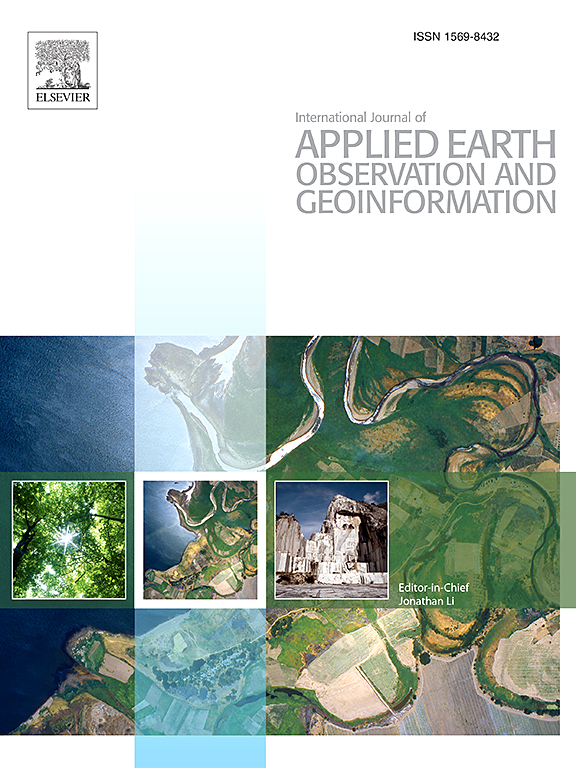利用时序遥感数据自动提取亚洲高山冰川非碎屑覆盖区域的先进深度学习技术
IF 7.6
Q1 REMOTE SENSING
International journal of applied earth observation and geoinformation : ITC journal
Pub Date : 2025-06-19
DOI:10.1016/j.jag.2025.104680
引用次数: 0
摘要
深度学习方法在自动冰川边界提取方面获得了突出的成就,因为它们的卷积操作具有局域性,可能导致冰川像素表示不完整或碎片化。此外,从单幅遥感影像(rsi)提取冰川边界的精度经常受到季节性雪、云、阴影和冰冻湖泊的影响。为了克服这些挑战,我们引入了一种从rsi中提取冰川非碎屑覆盖区域(NDCAG)的新模型,称为GlacierSTR-UNet。该模型通过将Swin Transformer (ST)作为编码器嵌入到u型架构中来增强信息流和整体性能,并通过将ResNet块集成到解码器中来减少训练时间并改善梯度处理。我们将GlacierSTR-UNet模型部署在谷歌Earth Engine (GEE)平台上,可以有效地从不同时期的rsi中生成多个NDCAG结果。然后应用逐像素合成算法对多个NDCAG提取结果进行聚合,生成最终的NDCAG。精度评价表明,GlacierSTR-UNet的总体精度为0.8817,自动提取的NDCAG与人工解译的NDCAG的相对偏差在2%以内。最后,我们获得了2015/2016年和2022/2023年亚洲高山区NDCAG数据集,发现2015/2016年至2022/2023年期间,NDCAG减少了4,185.12±7,870.96 km2。这些发现证明了我们的方法在有效和准确地提取NDCAG方面的有效性,突出了它在监测冰川变化和支持冰川清查工作方面的潜力。本文章由计算机程序翻译,如有差异,请以英文原文为准。
Advanced deep learning techniques for automated extraction of non-debris-covered areas of glaciers in High-Mountain Asia using time-series remote sensing data
Deep learning approaches have gained prominence for automatic glacier boundary extraction due to their localized nature of convolutional operations, potentially leading to incomplete or fragmented glacier pixel representations. Moreover, the accuracy of extracting glacier boundaries from a single remote sensing image (RSIs) is often influenced by seasonal snow, clouds, shadows, and frozen lakes. To overcome these challenges, we introduce a novel model for extracting the non-debris-covered areas of glaciers (NDCAG) from RSIs, termed GlacierSTR-UNet. This model enhances information flow and overall performance by embedding the Swin Transformer (ST) as an encoder into a U-shaped architecture and reduces training time and improves gradient handling by incorporating the ResNet block in the decoder. We deploy the GlacierSTR-UNet model on the Google Earth Engine (GEE) platform to efficiently generate multiple NDCAG results from RSIs taken at different periods. A pixel-by-pixel synthesis algorithm is then applied to aggregate the multiple NDCAG extraction results, producing the final NDCAG. Accuracy assessments indicate that GlacierSTR-UNet achieves an overall accuracy of 0.8817, and the relative deviation between automatically extracted and manually interpreted NDCAG remains within 2 %. Finally, we obtain the NDCAG datasets for the periods of 2015/2016 and 2022/2023 in High-Mountain Asia, revealing a reduction of 4,185.12 ± 7,870.96 km2 in NDCAG from 2015/2016 to 2022/2023. These findings demonstrate the effectiveness of our approach in efficiently and accurately extracting NDCAG, highlighting its potential for monitoring glacier changes and supporting glacier inventory efforts.
求助全文
通过发布文献求助,成功后即可免费获取论文全文。
去求助
来源期刊

International journal of applied earth observation and geoinformation : ITC journal
Global and Planetary Change, Management, Monitoring, Policy and Law, Earth-Surface Processes, Computers in Earth Sciences
CiteScore
12.00
自引率
0.00%
发文量
0
审稿时长
77 days
期刊介绍:
The International Journal of Applied Earth Observation and Geoinformation publishes original papers that utilize earth observation data for natural resource and environmental inventory and management. These data primarily originate from remote sensing platforms, including satellites and aircraft, supplemented by surface and subsurface measurements. Addressing natural resources such as forests, agricultural land, soils, and water, as well as environmental concerns like biodiversity, land degradation, and hazards, the journal explores conceptual and data-driven approaches. It covers geoinformation themes like capturing, databasing, visualization, interpretation, data quality, and spatial uncertainty.
 求助内容:
求助内容: 应助结果提醒方式:
应助结果提醒方式:


